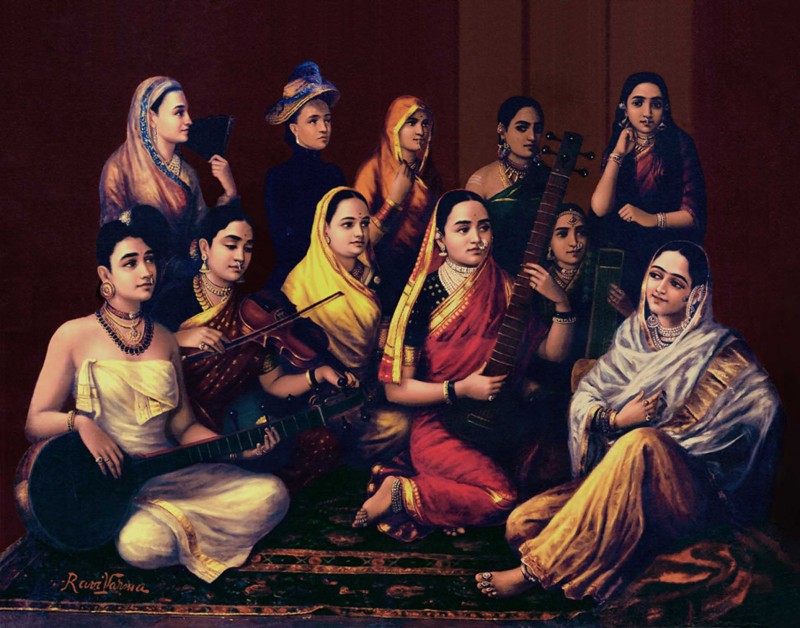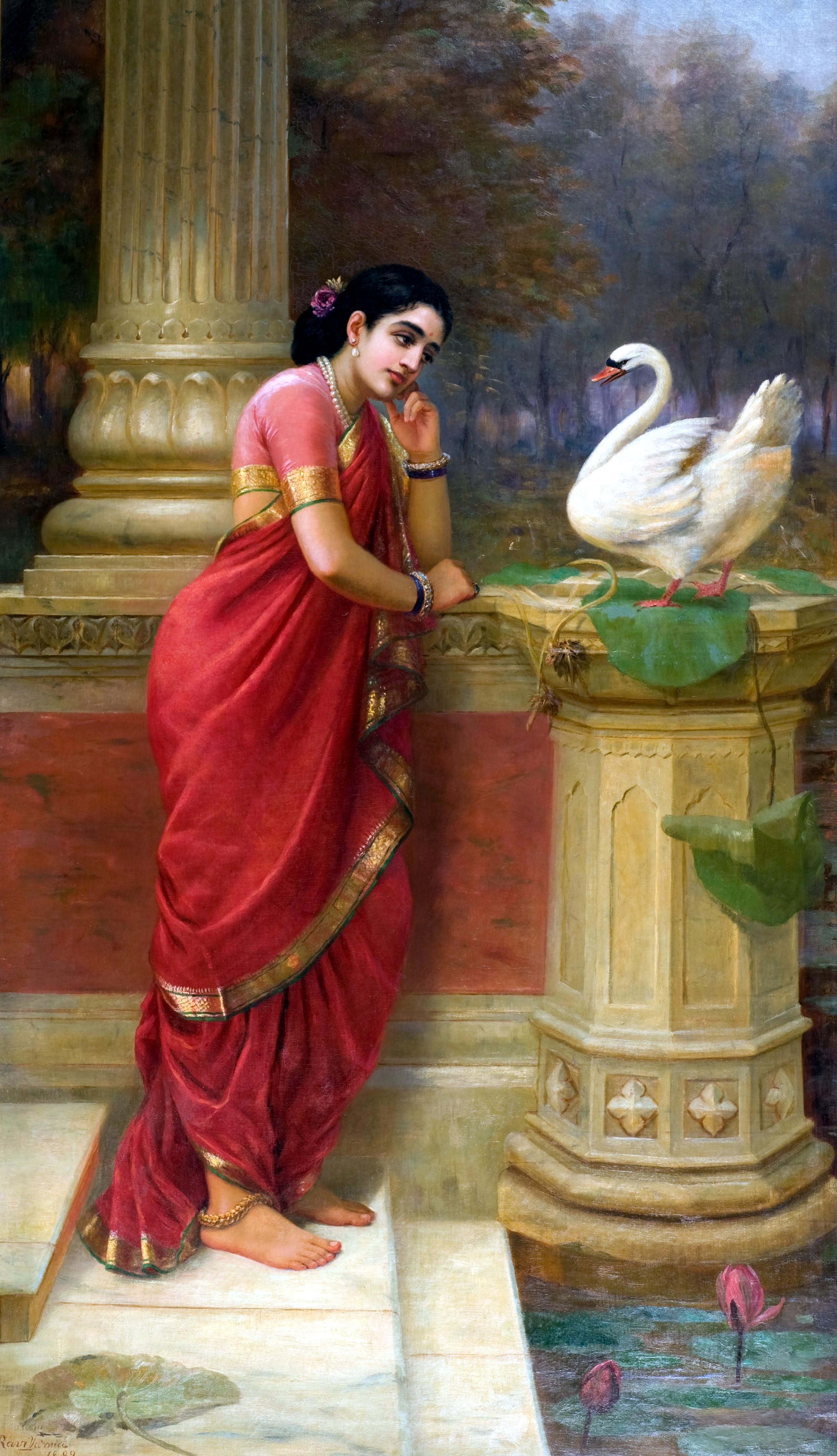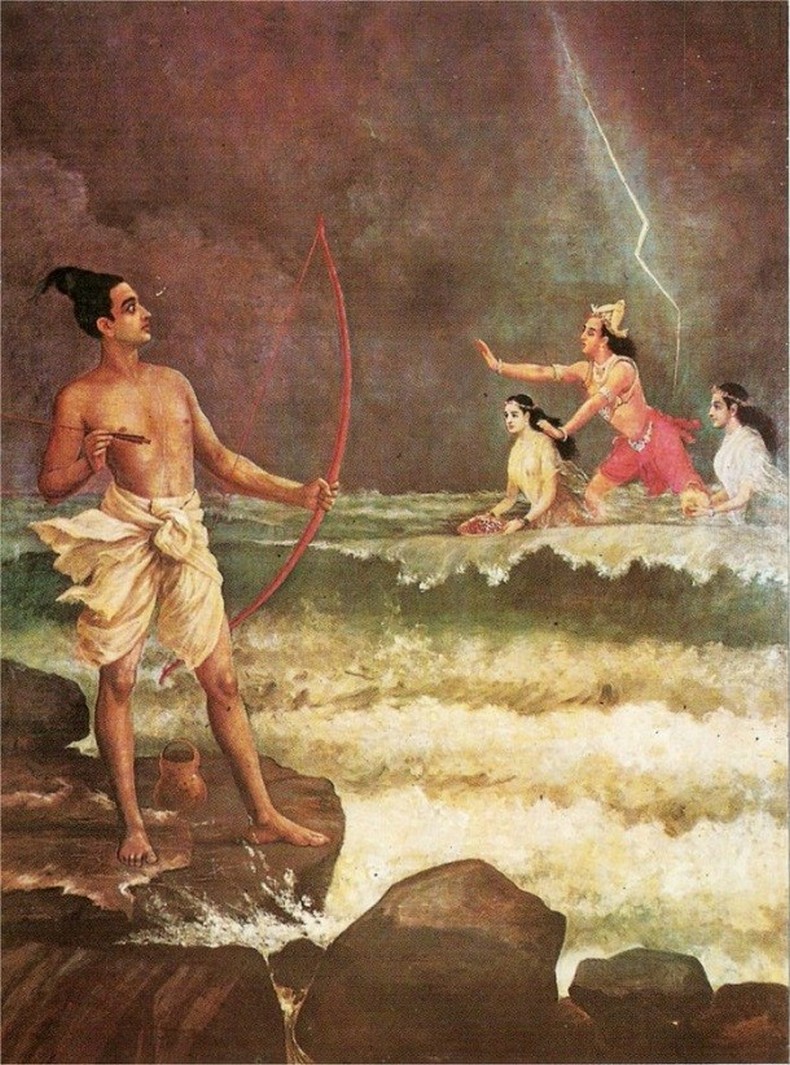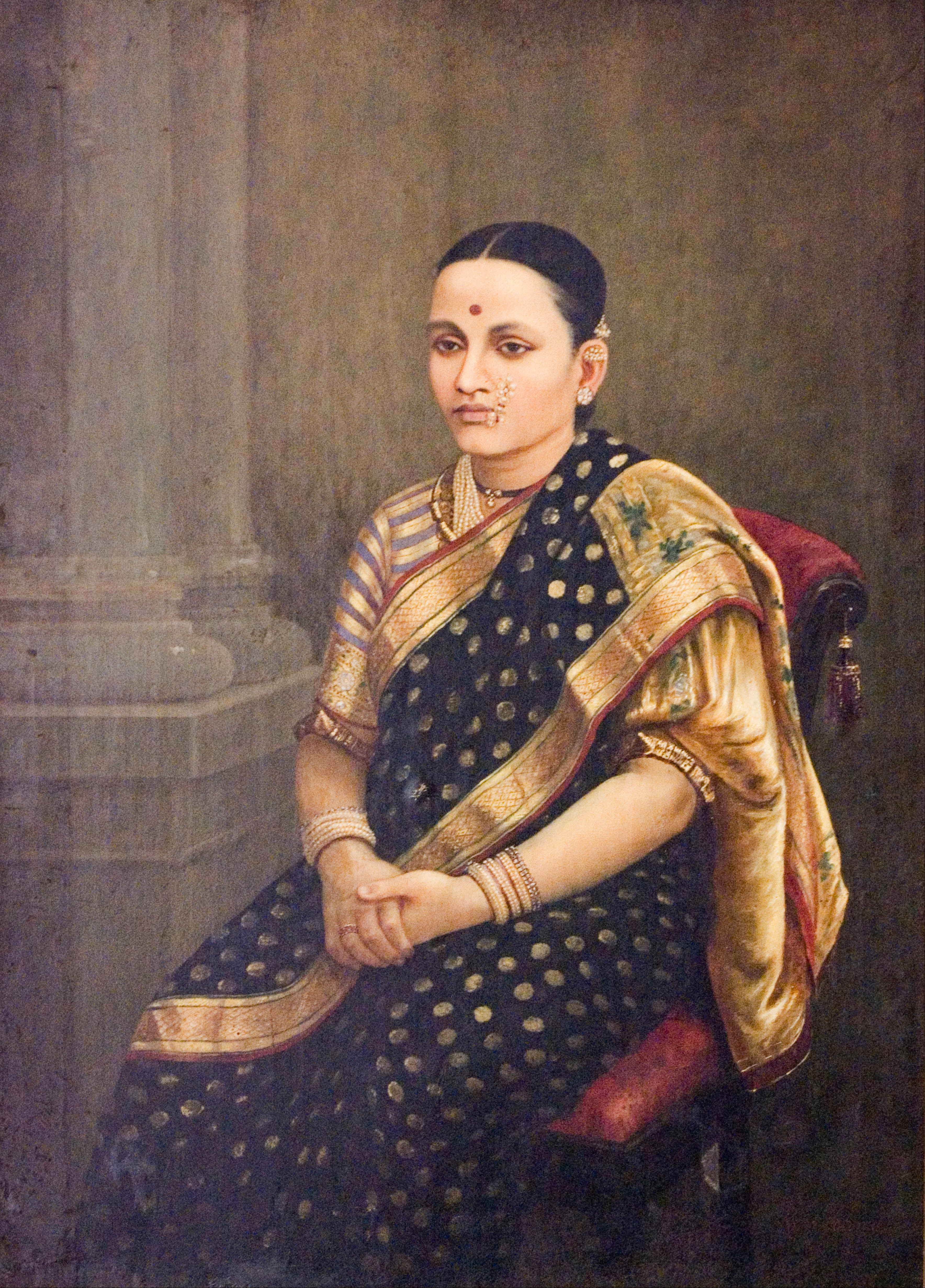 |
| Self portrait by Raja Ravi Varma Raja Ravi Varma, Public domain, via Wikimedia Commons {{PD-US}} |
Introduction: The Legacy of a Modern Indian Master
Raja Ravi Varma (1848-1906) is not merely a painter; he is a cultural icon, a pivotal figure who stands at the confluence of Indian tradition and Western modernity.
In an era of sweeping change, he mastered the European academic style of oil painting and perspective, wielding it to depict the rich tapestry of Indian mythology, history, and portraiture with unprecedented realism and emotional depth.
His genius lay in his ability to make the divine accessible and the aristocratic monumental, forever changing the Indian visual imagination.
More profoundly, through his lithographic press, the Ravi Varma Pictures Depot, he democratized art, ensuring that his depictions of gods and goddesses entered millions of middle-class homes, effectively standardizing the iconography of Hindu deities for generations to come.
 |
Raja Ravi Varma, Public domain, via Wikimedia Commons |
This comprehensive essay delves into the artistic specialties that define Raja Ravi Varma's oeuvre: his mastery over color and light, his ingenious fusion of European techniques with Indian sensibilities, his revolutionary approach to depicting the female form, and his unparalleled skill as a portraitist.
This work fetched upwards of $350,000 at auction.
Section 1: Artistic Specialties of Raja Ravi Varma
Before examining individual works, it is crucial to understand the core technical and stylistic innovations that form the bedrock of his artistry.
Synthesis of European Academicism and Indian Iconography: Varma received training from European artists like Theodore Jensen and mastered the techniques of oil painting, chiaroscuro (the dramatic use of light and shadow), and linear perspective.

Raja Ravi Varma Paintings in Baroda, Sairandhri
Raja Ravi Varma, Public domain, via Wikimedia CommonsHe applied these Western tools to quintessentially Indian subjects. His mythological scenes are not flat, symbolic representations but dramatic, naturalistic tableaux where Shakuntala looks like a living, breathing woman lost in thought, and Lord Rama possesses the idealized anatomy of a Greek hero.
Mastery of Color and Luminescence: Varma’s palette is legendary. He had an exceptional ability to render the sheen of silk, the glow of gold jewelry, the subtle textures of flowers, and the luminous quality of skin.
His backgrounds, often lush landscapes or ornate palace interiors, are not mere backdrops but integral to the mood and narrative, painted with a atmospheric quality learned from European landscape traditions.
The Humanization of the Divine and the Idealization of the Mortal: His most significant contribution was humanizing mythological figures. His gods, goddesses, and epic heroes exhibit relatable emotions—love, longing, pride, and despair. Conversely, his portraits of maharajas and their families elevate them to a near-divine status, capturing their power, elegance, and lineage with regal grandeur.
Revolutionizing the Depiction of the Sari and Indian Femininity: Varma had a profound influence on the visual culture of Indian womanhood. He depicted the sari with a new grace and realism, often using it to accentuate the form and movement of the female body. His women, whether divine or aristocratic, are portrayed with a combination of strength, beauty, and sensitivity that was groundbreaking for his time.
Section 2: A Gallery of Masterpieces – Artistic and Market Analysis
 |
| Shakuntala looking back to glimpse Dushyanta Raja Ravi Varma, Public domain, via Wikimedia Commons |
Here, we analyze eleven of Varma's most celebrated paintings, all of which are in the public domain and available for viewing on platforms like Wikimedia Commons.
1. Shakuntala (Looking for Dushyanta) (c. 1870)
Artistic Analysis: This is perhaps Varma's most narratively powerful work. It illustrates a moment from Kalidasa's epic play Abhijnanasakuntalam. Shakuntala, having been abandoned by King Dushyanta who is under a curse, pretends to remove a thorn from her foot while secretly glancing back at him, a gesture filled with shy love and anticipation.
Varma captures this fleeting, intimate moment perfectly. The composition is masterful; our eyes follow Shakuntala's gaze diagonally across the canvas to the figure of Dushyanta in the distance.
The lush forest setting, with its detailed foliage and soft light, creates a romantic, dreamlike atmosphere. The rendering of Shakuntala's simple attire and her delicate, expressive face showcases Varma's skill in portraying natural beauty and complex emotion.
Display and Market Value: The original painting is held at the Sri Chitra Art Gallery, Thiruvananthapuram. As a national treasure, it is irreplaceable and has not been on the commercial market for over a century. Its value is incalculable from a cultural standpoint. However, high-quality lithographs and reproductions based on this image became immensely popular, making it one of the most recognizable images in India.
 |
| There Comes Papa Raja Ravi Varma, Public domain, via Wikimedia Commons |
2. There Comes Papa (1893)
Artistic Analysis: This painting is a beautiful example of Varma's genre painting and his focus on domestic life.
It depicts his daughter, Mahaprabha Thampuratty, holding her younger brother, gesturing towards their approaching father. The charm of the painting lies in its simplicity and warmth. The children are dressed in contemporary, elegant clothing.
The older sister's expression is one of excitement and affection, while the baby's gaze is curious. The use of soft, natural light illuminating the children against a darker, indistinct background highlights their innocence and makes them the focal point.
It demonstrates Varma's ability to move beyond mythology and portraiture to capture tender, everyday moments.
Display and Market Value: This painting is part of the Sri Chitra Art Gallery collection. Like other works in major national collections, its value is patrimonial. It has never been auctioned in the modern era. Its "value" is demonstrated through its enduring popularity as a print, symbolizing familial love.

Galaxy of Musicians
Raja Ravi Varma, Public domain, via Wikimedia Commons

Raja Ravi Varma, Public domain, via Wikimedia Commons
3. Galaxy of Musicians (1889)
Artistic Analysis: This monumental work is a testament to Varma's ambition and his skill in composing complex group portraits.
It features eleven women, presumably representing different regions of India, gathered together making music. Each woman is adorned in distinct traditional attire and jewelry, showcasing Varma's meticulous research and ability to render diverse textiles.
The composition is pyramidal, creating a sense of stability and harmony. The figures are not just individual portraits but part of a cohesive narrative whole. The painting symbolizes a unified, culturally rich India, a powerful idea during the colonial period. The technical proficiency in rendering the various fabrics—from the transparent muslin to the heavy kanchipuram silks—is extraordinary.
Display and Market Value: The painting is housed in the Sri Chitra Art Gallery, Thiruvananthapuram. Its size, thematic importance, and iconic status place it among Varma's most significant works. It is beyond commercial valuation. If a work of similar stature and provenance were to appear on the market, it would undoubtedly command a price in the tens of millions of dollars, but it is effectively a national monument.
 |
Raja Ravi Varma, Public domain, via Wikimedia Commons |
Artistic Analysis: This painting depicts a dramatic scene from the Ramayana: the giant eagle Jatayu, mortally wounded by Ravana after attempting to save Sita.
Varma's academic training shines here. The fallen Jatayu is rendered with anatomical precision, his vast wings spread across the foreground.
The figure of Rama, rushing to the scene with Lakshmana, is dynamic and filled with pathos. The landscape is dramatic, with a dark, stormy sky reflecting the tragedy of the moment.
The painting is a masterclass in storytelling, capturing the climax of action and the emotional weight of Jatayu's sacrifice.
The contrast between the dark, powerful form of the demon-king Ravana's chariot in the sky and the heroic figures on the ground creates a powerful visual tension.
Display and Market Value: Located at the Sri Chitra Art Gallery, this work is a cornerstone of Varma's mythological output. Its value is historical and artistic. The lithographic reproductions of this scene were wildly popular, cementing this specific visualization of the epic in the public mind.

Hamsa Damayanti
Raja Ravi Varma, Public domain,
via Wikimedia Commons

Raja Ravi Varma, Public domain,
via Wikimedia Commons
5. Hamsa Damayanti (1899)
Artistic Analysis: This painting illustrates a story from the Mahabharata, where the princess Damayanti, who is in love with King Nala, is confronted by a golden swan (Hamsa) that speaks to her of his virtues.
Varma captures the moment of surprise and curiosity on Damayanti's face as she listens to the swan. The setting is a lavishly decorated palace interior, allowing Varma to showcase his skill in rendering architectural details, intricate carpets, and rich textiles.
Damayanti is portrayed as the ideal of classical Indian beauty, adorned in exquisite jewelry and a finely detailed sari. The composition is balanced, with the swan acting as a narrative bridge between the princess and the unseen object of her affection.
Display and Market Value: This painting is also part of the permanent collection at the Sri Chitra Art Gallery. Its value in the art market is not quantifiable due to its status as a national treasure. Its cultural value, however, is immense, as it represents the pinnacle of Varma's "mythological realism."
 |
Raja Ravi Varma, Public domain, via Wikimedia Commons {{PD-US}} |
Artistic Analysis: This portrait exemplifies Varma's prowess as a court painter. Maharani Chimnabai II is depicted with regal authority and grace. She stands confidently, adorned in the magnificent pearls and silks of the Baroda royalty.
Varma's attention to detail is breathtaking: the intricate zari work on her sari, the lustrous pearls around her neck, and the delicate embroidery on her blouse are rendered with photographic realism.
Her expression is calm, confident, and slightly aloof, perfectly capturing the dignity of her position.
The dark, neutral background ensures that all attention is focused on the opulence of her attire and her commanding presence.
This portrait is not just a likeness; it is a statement of power, wealth, and cultural sophistication.
.jpg)
At Younger Age
Raja Ravi Varma, Public domain,
via Wikimedia Commons {{PD-US}}Display and Market Value: The portrait is believed to be part of the Baroda Museum & Picture Gallery collection or a private collection of the Baroda royal family.
Portraits of this caliber, if they ever appear at international auctions (which is rare for core royal collection pieces), can fetch astronomical sums.
A comparable portrait by Varma could be valued in the range of $1-3 million or more, depending on provenance, size, and condition, but it is likely held in a permanent trust.
7. Lady in the Moonlight (c. 1890)
Artistic Analysis: This painting showcases Varma's romantic sensibility and his mastery of mood and atmosphere.
A young woman stands on a balcony, bathed in the soft, silvery light of the moon. She holds a veena, and her gaze is contemplative and melancholic.
.jpg)
Raja Ravi Varma, Public domain, via Wikimedia CommonsThe painting is a study in tonal harmony. The cool moonlight defines the woman's white sari and illuminates her features, creating a serene, almost ethereal effect.
The success of the painting lies in its evocative mood rather than a dramatic narrative. It demonstrates Varma's ability to capture a quiet, poetic moment, influenced by European Romanticism but infused with a distinctly Indian spirit.
Display and Market Value: The current location of the original is often listed as a private collection.
Paintings like this, which are smaller in scale and more intimate in subject matter than his grand mythological works, do occasionally appear on the market.
Given its beauty and the artist's stature, a work like Lady in the Moonlight could achieve a price well over $500,000 to over $1 million at a major auction house like Sotheby's or Christie's.
 |
Raja Ravi Varma (1848 - 1906), Public domain, via Wikimedia Commons |
Artistic Analysis: This painting depicts one of the most tense and morally charged scenes from the Mahabharata: the disrobing of Draupadi in the royal court.
Varma chooses the moment of divine intervention, where Lord Krishna protects her modesty by providing an endless stream of cloth. Draupadi is shown in a pose of despair and prayer, her expression one of anguish and faith.
The surrounding courtiers exhibit a range of emotions, from the vile glee of Dushasana to the shame and anger of the Pandavas.
The composition is theatrical, with the central figure of Draupadi illuminated, drawing the viewer's sympathy.
Varma's skill is in rendering the collective drama of the scene and the psychological states of each character.
Display and Market Value: The original is housed at the Sri Chitra Art Gallery. Its value is foundational to Indian art history. The lithograph of this scene was particularly powerful, serving as a visual parable of faith and divine justice for millions of Indians.
 |
Raja Ravi Varma, Public domain, via Wikimedia Commons |
Artistic Analysis: In this painting, Varma depicts Krishna not in his divine, cosmic form, but as a royal envoy and statesman from the Mahabharata.
He is shown standing with a composed and diplomatic demeanor, ready to deliver a message to the Kaurava court.
The portrayal is remarkably humanistic. Krishna is handsome and dignified, adorned in royal attire rather than his typical peacock feathers.
This reflects Varma's tendency to present mythological figures in a realistic, relatable context.
The painting highlights Krishna's role as a strategic thinker and peacemaker, adding a layer of political narrative to his divine persona.
Display and Market Value: This work is part of the collection at the Sri Chitra Art Gallery. Its value, like the others in the gallery, is immeasurable in commercial terms. It is significant for its unique interpretation of a well-known deity.
 |
Raja Ravi Varma, Public domain, via Wikimedia Commons |
Artistic Analysis: This is a classic example of Varma's idealized portraiture of Indian women.
The subject, whose identity is often debated, is depicted holding a fruit, her body in a graceful, slightly curved posture.
The focus is on her serene beauty, her traditional jewelry, and the rich, red sari she wears.
The background is a lush, dark garden, which helps her figure stand out. The painting is less about narrative and more about celebrating feminine beauty and elegance.
It exemplifies the "Raja Ravi Varma style" of womanhood that became the standard for beauty in Indian popular art for decades to come.
Display and Market Value: The original is in a private collection. Such portraits are highly sought after by collectors of Indian modern art. At auction, a high-quality portrait of this nature could command a price between $300,000 and $800,000, influenced by factors like the identity of the sitter and the painting's provenance.
 |
| Raja Ravi Varma, Public domain, via Wikimedia Commons Sri Rama Vanquishing the Sea |
11. Rama Vanquishing the Sea (1900)
Artistic Analysis: This painting depicts a dramatic moment from the Ramayana where an enraged Lord Rama, frustrated by the ocean god Samudra's refusal to yield a path to Lanka, raises his bow to dry up the sea with his celestial arrows.
Varma captures Rama's divine fury and power. His stance is dynamic and authoritative, while Lakshmana looks on with concern.
The sea is rendered with turbulent waves, and the sky is heavy with clouds, amplifying the drama. The painting is a powerful representation of divine will overcoming natural forces.
Varma's use of color and composition successfully conveys the tension and epic scale of the scene.
Display and Market Value: This work is held at the Sri Chitra Art Gallery. As a key mythological work, it is an integral part of India's national art collection and is not for sale. Its value lies in its contribution to the visual canon of the Ramayana.
|
|
|
Raja Ravi Varma's art style is best described as a fusion of European academic realism and Indian aesthetics.
 |
| Self portrait by Raja Ravi Varma Raja Ravi Varma, Public domain, via Wikimedia Commons {{PD-US}} |
Section 3: Display, Legacy, and the Modern Market
National Treasures: The icons of his career—Shakuntala, Galaxy of Musicians, Jatayu Vadham—are owned by public institutions and are legally protected as national assets. They are not for sale and are therefore considered priceless.
Auction Rarity: Genuine, major oil paintings by Varma very rarely appear on the open market. When they do, they are seismic events in the art world.
Provenance is Key: The value of a Varma painting is heavily dependent on its provenance. A portrait from a famous royal collection will fetch exponentially more than a similar work from an unknown source.
The Lithograph Market: There is a vibrant secondary market for original, high-quality oleographs (lithographs) from the Ravi Varma Press. These are collectible in their own right, with rare and well-preserved prints selling for thousands of dollars.
 |
Raja Ravi Varma, Public domain, via Wikimedia Commons |
A Lady Playing Swarbat (also known as Portrait of an Arsi Lady), was discovered and auctioned by Sotheby's. Conclusion: The Undiminished Radiance
 |
| Stolen Interview {{PD-US}} Raja Ravi Varma, Public domain, via Wikimedia Commons |
Raja Ravi Varma's legacy is omnipresent in modern India. From calendar art to cinema aesthetics, from the depiction of gods in temples to the visual language of popular prints, his influence is inescapable.
He was more than a painter; he was a visionary who created a new visual language for a nation. He taught Indians to see their own stories through a lens that was both modern and deeply respectful of tradition.
His paintings are not frozen relics of the past but living, breathing artifacts that continue to captivate, inspire, and define beauty for millions.
The artistic specialties he pioneered—the fusion of East and West, the humanization of myth, the luminescent realism—ensure that his radiance remains undimmed, securing his place as the father of modern Indian art.
.jpg)

